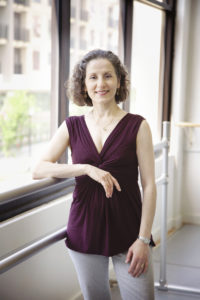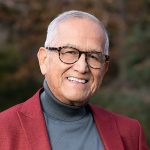Ballet fans are rejoicing because professional ballet is returning to our city with the Indianapolis Ballet debut residency featuring three performances February 16-18 at Tobias Theatre at Newfields. The program will include “Raymonda– Act III,” the concert version of George Balanchine’s “Who Cares?” and Stravinsky’s “The Firebird.”
As part of its debut residency, Indianpolis Ballet returns Yoshiko Kamikusa to Indianapolis as a company member. The award-winning dancer was a guest performer during “The Nutcracker” this pat December. Also joining Kamikusa for Indianapolis Ballet’s debut season is British perrformer David Ward, who will be featured as a residency guest artist for upcoming performances at The Toby . Kamikusa and Ward join last summer’s founding member’s Chris Lingner and Kristin Young Toner and an ensemble of dancers that include Camila Ferrera, Jessica Miller, Katherine Sawicki and Mary Ann Shaefer as members of the full company for Indianapolis Ballet’s 2018 debut season.

Victoria Lyras – Courtesy of Indianapolis Ballet. Used by permission.
The force behind this exciting development is Indianapolis Ballet Artistic Director Victoria Lyras. A native of Athens, Greece, Lyras received her training at The School of American Ballet. While studying there, Ms. Lyras performed children’s roles with the New York City Ballet. Upon graduation at the age of 17, she joined the Pennsylvania Ballet. During her association with the Pennsylvania Ballet, Lyras danced principal and/or soloist roles in the Balanchine repertoire. In 1984, she toured and performed with Edward Villella and Dancers, Oklahoma City Ballet, Eglevsky Ballet and the Harrisburg Ballet. During the 1991-92 season, Lyras appeared as a guest artist with the Indianapolis Ballet Theatre in a special program, which included Jeffrey Gribler of the Pennsylvania Ballet, and Panayis Lyras, Lyras’s brother and internationally-renowned concert pianist. Lyras has also appeared as a guest artist with many other regional ballet companies throughout the United States. In 1996, she joined the professional staff of the Sky Rink at Chelsea Piers in New York City, and directed the ballet program designed exclusively for figure skaters. She has taught off-ice company classes for the Ice Theatre of New York. That same year, she founded “Lyrical Designs,” in which she designs and executes competitive figure skating dresses, tutus, ballet costumes and headpieces. Lyras founded the Indianapolis School of Ballet in August 2006. Since opening, ISB students have performed eight years of repertoire choreographed or staged by Lyras. Since 2011, Lyras has taught the ballet majors at Indiana University’s Jacobs School of Music as adjunct lecturer.
Recently, I sat down with Lyras in the downtown Indianapolis School of Ballet, administrative offices and studios in a building at the corner of Capitol and Michigan Street to chat about her background, as well as her professional and personal values. Herein is our conversation drawn from an edited transcript of the interview.
How are rehearsals going?
It’s going pretty well. The choreography is all done. We are basically running the program at this point. We are working out the technicalities—the lifts, the transitions and, of course, until you get into the theater with the scenery and the sets and the props, that’s another whole learning curve.
What are your criteria for selecting dancers?
My criteria are a minimum of three years of professional experience with a professional ballet company. They must have a physical look. Not that I want them to all look alike. We have a beautiful array of dancers. They have to adapt to the Balanchine style and experience would be beneficial. They need to have that certain spark or magic. First and foremost, they must have musicality. That is everything. If you are not one with the music you cannot dance a Balanchine ballet. Also, physical strength, the work ethic, technical attributes and their artistic approach. Do they have the sensitivity; do they feel it? Also, what is their character? Who are they as people? What can they bring to the organization? You want to make sure the family is well-balanced and there is unity in the community. The dancers who are here are so excited to be part of this new organization. They are making history. They are fulfilling their dreams. There is tremendous camaraderie here. We have a common goal and that is the artistic product we put on the stage.
Any particular reason for choosing “The Firebird” as part of your program?
“Firebird” is very dear to my heart and soul. When I was child dancing at The School of American Ballet, I was one of the four flower pots. I wanted to do the ballet several years ago as the school was growing, but I kept putting it off. It was almost three or four years ago that I approached Mark Smith, the scenic designer at IU. We talked about it over the years and finally last year I said “Mark, it’s time for us to do the ballet. Let’s get this done.” I decided that the week of Valentine’s Day would be an ideal time to debut the company. It made sense for me to do a strong program with lots of red. And lots of love. Spreading the love is what we do.
What is your relationship to Balanchine?
As far as the methodology or what we follow in this organization. I am a product of The School of American Ballet, nine years’ worth. I started there as a young girl of eight and graduated at 17. That is the George Balanchine School that he founded in 1934. His dictum was always “At first, the school.” We started with the school. The vision of the school has always been here since day one. The late Karl Zimmer, Jr., who was our founding board member, saw the ultimate vision of the organization and he agreed with Mr. Balanchine. You start with a school, with your style and the technique you want to be teaching which is Balanchine’s. It is where my soul is. Then, you work to cultivate and develop your dancers. We did that. They spread their wings by going to elite university programs, by dancing in other ballet companies and now some of them are choosing to come back here and dance with us. So the Balanchine style and technique is the way I teach my classes. It’s the major difference between our organization and others. Before us, it didn’t exist in Indianapolis.
How did you bring local ballet patrons back into the fold?
It has been a very long and tough road. When a metropolitan community loses a professional institution in whatever art form, it is such a blow to the community. The first thing that happens is this black cloud and people say, “The community doesn’t support it.” I don’t think that’s true. I think that arts organizations are not managed with a strong business sense and aren’t fiscally responsible and held responsible for how it’s managed. If they fail, there all these other negative connotations arise around it. That is what happened with Ballet Internationale. From what I have heard, it was financially mismanaged, so that is one thing I said I was not going to do. That would be like shooting myself in the foot. That is not the way you go about something. The most important thing for me was to start the school, build the school, build it on a solid foundation and operate it in the black, which we have done over the last 11½ years now. Then you build the enthusiasm and the trust of the community, which leads to a desire and an interest in supporting this art form. There has to be a real sense of community and commitment, but ultimately, you have to have a strong business plan, which we developed. It took us ten years. But I was also told 12 years ago by my advisers, if your budget is going to be a million dollars, you want to make sure you have a million and a half in the bank because if you don’t have that other 50 percent, your next year is not going to happen. So, I listened very carefully to my inner-circle of advisers. Some of them are here locally and some are on the East Coast and they are my support system.
Do you have a strong board?
You have to have a board that is 100 percent vested, enthusiastic, and on fire. It is hard. We are a small organization. Small, but mighty. The board has to be actively engaged and they are.
Who creates your costumes?
My mother and I create them. Most of them are done. I just finished the Firebird costume. Making costumes is such an incredibly time-consuming job, particularly the way I like them. That is the next step, to hire a full-time costumer. I just can’t do it any longer. My mother has been the force behind it. The two of us make an incredible team. We have produced thousands of costumes for the organization and Firebird is no exception.
Who are your influences?
I have been at the right place at the right time. I met Violette Verdy when I was ten years old. She and Patricia McBride were my childhood idols. I could relate to them as extraordinary ballerinas on the stage, but offstage, they were very approachable. I danced with The School of American Ballet in children’s roles for seven years. I danced in thousands of performances. We had 20 Nutcrackers. You could go up to them after a performance. You could thank them and tell them how they moved and inspired you and they would talk to you for the next five minutes. Generosity starts from the top. The male dancer that probably influenced my life more than anybody else would be Edward Villella, the most legendary male dancer to come out of New York City Ballet. He started at The School of American Ballet. Balanchine really developed him into the star that he became. When I was a little girl, I held his cape when he danced Oberon in “A Midsummer Night’s Dream.” I was in “Harlequinade.” I was one of the little harlequins who helped fight off the bad guys. But an extraordinary thing happened with Edward Villella when I was dancing principal solo roles with Pennsylvania Ballet the early 80s. I got a call from Edward’s agent in New York telling me he needed a small ballerina to partner and would I be available and I said, “Are you kidding me?” I was dancing five days a week rehearsal periods with Pennsylvania Ballet, and then on Thursday, I would get on the train in Philadelphia and go up to New York, rehearse a bit, and then the next day, I was on a plane or bus or van or whatever and I would be dancing Saturday and Sunday with Edward. He partnered me in “Stars and Stripes Pas de Deux,” “Swan Lake Act 2” and every performance I closed with Balanchine’s “Tarantella.” So, we did this tour of Edward Villella and Dancers and we traveled all across the states and did one or two performances every weekend. So, Edward is one of my lifelines. Whenever I need something, I call him and he answers the phone. That, to me, is so heartwarming. I met him when I was 23.
Has Villela given you any pointers about your new company?
Absolutely. Last January, when I went to visit him at his home in New York, I took him the business plan and he read it. We talked about it. He is one of my artistic advisers. He has been an artistic adviser since day one, as was Violette Verdy.
Where do your drive, passion and chutzpah come from?
I don’t know where the drive and the passion come from. I am pretty fearless. I like to do things right and well. I think that is part of being a dancer and always seeking a higher artistic and technical level. You want that sense of perfectionism, but at the same time, you have to manage it so that you don’t get obsessive in a negative way. That is what I say to the dancers. You have to obsess about the details, but you have to keep it in a very positive light in your mind.
As far as the chutzpah, I think the love for dancing; the love for music is in my soul. When I was 12 years old, I was told I would never be a professional ballerina because I wasn’t strong enough; I wasn’t tall enough; I wasn’t good enough; I wasn’t this or that. You know, that is someone’s opinion. I am not that person. I don’t like to put people down. The sky is the limit. I have learned to give everyone the opportunity to spread their wings and challenge them on a very high level. I am a worker and I expect that from my dancers and that is the way they are. No one can tell you that you are not good enough. No one can make that decision for you. It is possible that we, ourselves, can make wrong choices, but if we do make wrong choices, it is important to learn from them and then make good choices. So, in my life, I have persevered to make good choices. Smart choices, I take calculated risks so I guess that is where it comes from.
I was not born in this country. I didn’t speak the language. I didn’t understand. I started at The School of American Ballet when I was nine years old. English is my second language, so, for me to understand French vocabulary with broken English coming from Russian teachers when my first language was Greek and all I heard was “No, No, No gut. No gut.” You know, it is very hard to process that as a young child when you don’t understand and you can’t ask questions such as “How do I make it better?” So, for me, teaching a dancer, that is the easy part. I can teach anybody to dance. And Edward Villella said the same thing to me. We were sitting at Capital Grille downtown when he was here in 2008 and I asked him, “How do you select that special dancer when you have thousands of dancers auditioning for you?” And he said, “I can teach anybody to dance.” However, that something special that some dancers have—that, you can’t teach. You either have the magic or you don’t. I was told I had the magic and that is what I have held on to, that and the deep love in my soul for the art form and for the music.
For tickets and information about Indianapolis Ballet’s debut residency, visit indyballet.org.





